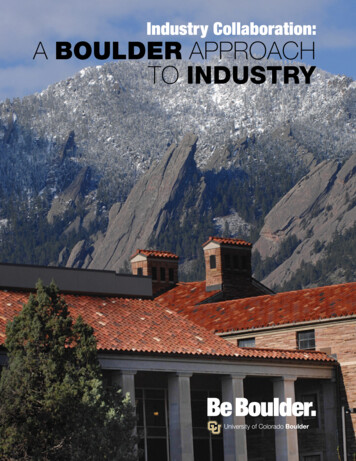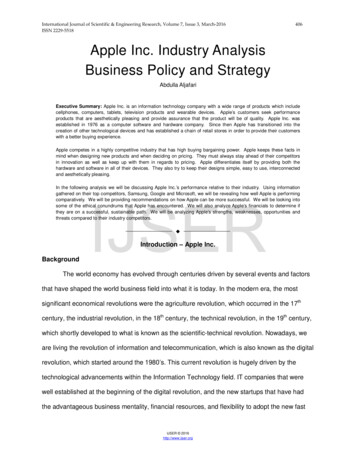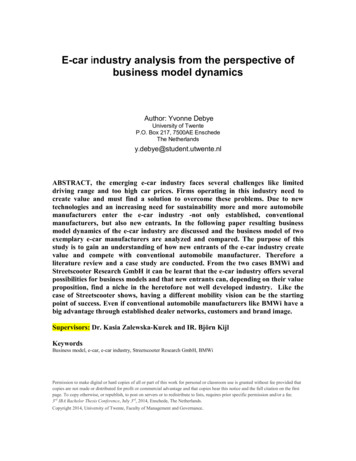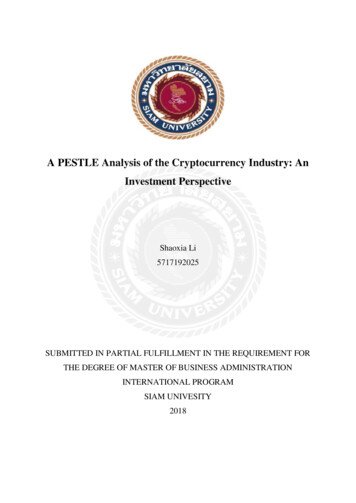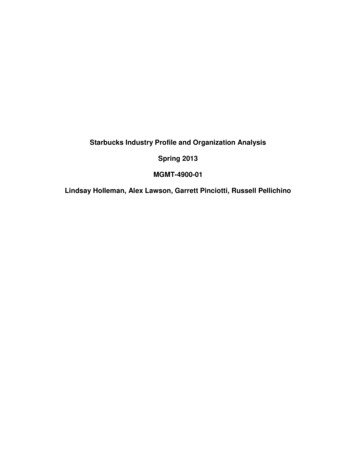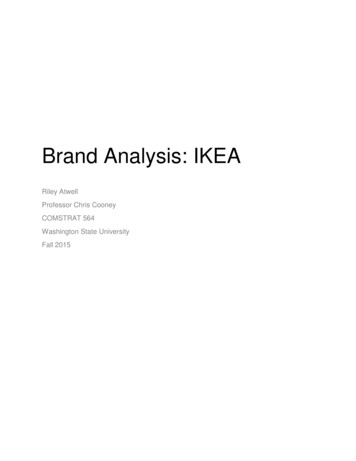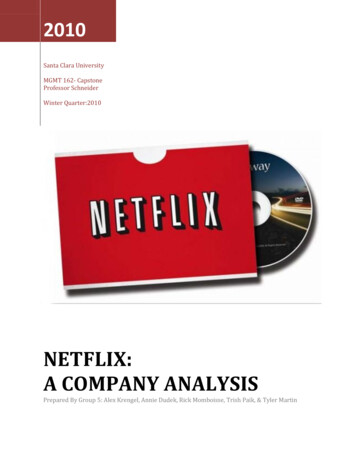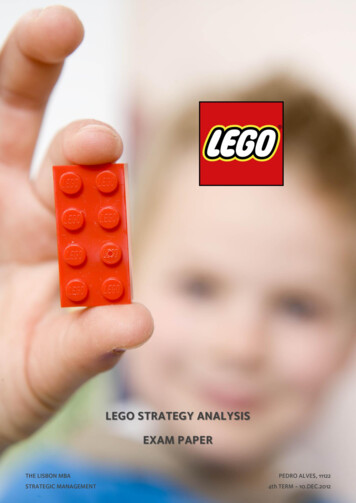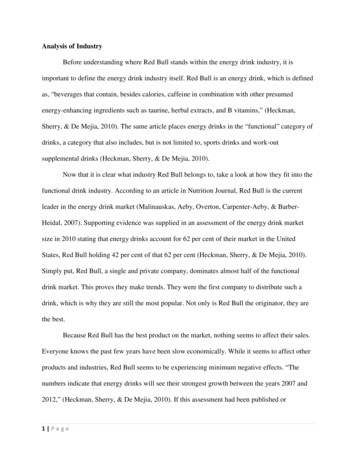
Transcription
Analysis of IndustryBefore understanding where Red Bull stands within the energy drink industry, it isimportant to define the energy drink industry itself. Red Bull is an energy drink, which is definedas, “beverages that contain, besides calories, caffeine in combination with other presumedenergy-enhancing ingredients such as taurine, herbal extracts, and B vitamins,” (Heckman,Sherry, & De Mejia, 2010). The same article places energy drinks in the “functional” category ofdrinks, a category that also includes, but is not limited to, sports drinks and work-outsupplemental drinks (Heckman, Sherry, & De Mejia, 2010).Now that it is clear what industry Red Bull belongs to, take a look at how they fit into thefunctional drink industry. According to an article in Nutrition Journal, Red Bull is the currentleader in the energy drink market (Malinauskas, Aeby, Overton, Carpenter-Aeby, & BarberHeidal, 2007). Supporting evidence was supplied in an assessment of the energy drink marketsize in 2010 stating that energy drinks account for 62 per cent of their market in the UnitedStates, Red Bull holding 42 per cent of that 62 per cent (Heckman, Sherry, & De Mejia, 2010).Simply put, Red Bull, a single and private company, dominates almost half of the functionaldrink market. This proves they make trends. They were the first company to distribute such adrink, which is why they are still the most popular. Not only is Red Bull the originator, they arethe best.Because Red Bull has the best product on the market, nothing seems to affect their sales.Everyone knows the past few years have been slow economically. While it seems to affect otherproducts and industries, Red Bull seems to be experiencing minimum negative effects. “Thenumbers indicate that energy drinks will see their strongest growth between the years 2007 and2012,” (Heckman, Sherry, & De Mejia, 2010). If this assessment had been published or1 Page
researched prior to 2007, it would not have much validity. However, because it was published in2010, mid-way through the expected growth dates, the assessment proves the energy drinkmarket is still growing, with Red Bull leading the group. Since not even horrible economic timescan hurt the sales of energy drinks, specifically Red Bull, there is no emerging industry that willinfringe on Red Bull sales.Analysis of CompanyRed Bull Energy Drink was developed by Dietrich Mateschitz. While in Asia onbusiness, he tried some syrups that people would add to their drinks to give them energy.Mateschitz worked to develop an energy drink called, Red Bull Krateng Dang. This originaldrink was only sold in Asia. After, making some changes to the drink, Mateschitz founded thecompany. In 1987 Red Bull was launched in Austria (Hoover's Inc., 2011).Every company goes through highs and lows. One low for Red Bull was when it wasinitially created. The original drink was not carbonated and very syrupy. This was not good forsales. Red Bull re-developed the brand, took out the syrup, and made it carbonated (Hoover'sInc., 2011). Since then Red Bull has been growing. Red Bull is experiencing the high point of thebrand. Currently Red Bull commands about 70 percent of the energy drink market (Gorse,Chadwick, & Burton, 2010).The philosophy behind Red Bull is to never give up, it is shown in their history that theykeep doing more and reaching out in new ways to promote the brand. Whether it’s buying asports team or creating a magazine, Red Bull does not give up. (Gorse, Chadwick, & Burton,2010).2 Page
The main way media has covered Red Bull is through the sports that Red Bull sponsors.A lot of Red Bull’s marketing is done through extreme sports, which is a new and innovativeapproach to promote a brand (Gorse, Chadwick, & Burton, 2010).Red Bull is very involved with the community. The company hosts many sports events ina way to market their product. Red Bull has come into the community by being such a bigsponsor of sports(Gorse, Chadwick, & Burton, 2010). Finally, Red Bull has become immersed inthe community is by their existence in night clubs (Cirillo, 2009).In some ways Red Bull is innovative. Red Bull was one of the first to break into theindustry of energy drinks. However, over the course of Red Bull’s history there has been littleinnovation within the company in relation to the product. Red Bull has only added the sugar freedrink, an energy shot and a cola to their energy drink list. These new products have not been assuccessful as the original. One main way Red Bull has been innovative is in their advertisingstrategies (Cirillo, 2009).Some of the key personnel and manegers in the Red Bull company are, DietrichMateschitz who is the founder, Nigel Trood the Director in United Kingdom, Elton Sawyer thedirector of competitions, John Probst who works with Red Bull Racing, Ellen Applen thedirector of communications, Walter Bachingerthe head of controlling and accounting, andPatrice Radden the director of the corporate communications (Hoover's Inc., 2011).The employees who come in direct contact with the consumers are people who work thespecific Red Bull events. An example would be the “Red Bull Girls.” These girls go to heavilypopulated areas or events and give out Red Bull (Boostmyproduct.com, 2011).Red Bull offers the standard energy drink, as well as a sugar free energy drink, an energycola, and their newest addition the energy shot (West, 2011). The primary energy drink for Red3 Page
Bull is the staple of the company. It is very important, because it is the product that continues tosell to the largest population of consumers and it is what took Red Bull from small companysales to global (Gorse, Chadwick, & Burton, 2010).Analysis of BrandCustomers feel that the Red Bull brand is relatively expensive as an energy drink option,but it still works and is effective towards their needs and wants, (Red Bull Survey Instrument ,2011).The Red Bull brand matches up with the consumers’ needs for a boost of energy to eitherjump-start their day or to get ready for a sporting event, while meeting their problems oftiredness. Red Bull also matches up with the consumers wants for a mixer to add to an alcoholicdrink and/or an energy boost while satisfying their interests of sports and being active, (Lowry,2004).Red Bull exceeds consumer expectations by surprising the consumer with free handoutsof the product by attractive looking promoters (Boostmyproduct.com, 2011). Red Bull also hasintroduced a sugar free version and a cola to the product line up which broadens the availabilityof a product that fits the customer (Redbull.com, 2011).Analysis of Consumer AnalysisSome of Red Bull’s consumer demographic characteristics include athletes,workers, and clubbers. Red Bull is known to revitalize your mind and body giving you that extraenergy to boost you through your day. According to Smith Kline Beecham Energy & SportsDrinks Report, “has shown that 53% of the people who drink energy/ sports drinks are within theage between 14-34 years,” (Drawert). The age targeted fits all the categories listed above.4 Page
Some competitors include Monster, Rockstar and Five-hour energy shots. These are theleading competitors, but according to the Hoover Company records, “Red Bull now dominatesthe world's energy-drink market with a 40% market share,” (Hoover's Inc., 2011). This relates tothe competitive customers because it indicates that there are few competitors, which translates tofewer competitor customers.The energy-drink market is dramatically growing with new products being marketed eachyear. Since Red Bull emerged it Five-hour energy has had a huge impact on energy drinks. Forexample, “The red-hot segment of the energy drink market currently is ‘energy shots,’ which isgrowing at a rate of about 35% annually, compared with 10% for energy drinks like Red Bulland Monster. Shots, including 5-hour Energy and a long list of imitators, rang up 1.5 billion insales in 2010 and make up about 14% of the energy drink market(Hoover's Inc., 2011). Thisemerging market increases the amount of energy-drink or shot users.The geographical characteristics for Red Bull are vast. Red Bull is a global company thatoriginated in Austria. For instance, “Red Bull, which makes several variations of its energy drink-- including Red Bull Simply Cola (launched in 2008) -- claims that about 4 billion cans of Redbull are consumed annually worldwide. Its 2009 turnover was E3.3 billion ( 4.4 billion), withincreases from the previous year in the Far East ( 43%), France ( 32%), Brazil ( 30%), andGermany ( 18%),” (Hoover's Inc., 2011). Red Bull is growing globally in both and consumerbase, and market shares.Psychographics include attitudes, buying history etc. Since Red Bull is such a largecompany and is spread so vast globally it is hard to place specific psychographics. Instead, “thebest solution would be to set the target market as a behavioral segmentation. The reason for thatdecision is because in a behavioral segmentation the individual’s relationship with the product5 Page
and the use and benefit sought from the product,” (Drawert). This helps identify and pinpointvarious benefits that normally you could not achieve.A consumers schedule effects how and when they drink Red Bull. There are peaks in themorning, mid-afternoon and late nights in sales. A consumer of Red Bull utilizes the kick itprovides to help assist them through the day.Consumers base their buying behavior on necessity, in addition to societal pressures. Onaverage consumers buy Red bull at large in the nighttime as well as the early morning. A heavyconsumer of Red Bull buys on average two a week, while a light consumer drinks one a month.Red Bull uses the end product for consumer sales. They market their product globally inabout twenty different countries. Red Bull sells, “Red Bull, Sugar Free Red Bull, Red Bull Cola,and the newest edition the Red Bull energy-shot,” (Hoover's Inc., 2011). Red Bulls target marketrange from 14-34 years of age.Consumer buying decisions are based upon social pressures, trends, needs, and desires.All of the above affect the sales and amount of purchases. Red Bull is the main competitor in themarket, which also increases the buying decision.Red Bulls information regarding the ingredients and effects of the products are their mostimportant. According to Red Bull, “Red Bull Energy Drink has been developed for people whowant to have a clear and focused mind, perform physically, are dynamic and performanceoriented whilst also balancing this with a fun and active lifestyle,” (Red Bull). This informationdescribes the intent and reasoning behind the drink.Red Bull gets most of their information from scientists and researchers that back up andsupport the product. The owner, “Dietrich Mateschitz often traveled to Asia as part of his job.During one of these travels, he was introduced to syrups that Asian business executives added to6 Page
their drinks for energy,” (Hoover's Inc., 2011). Experts in the field also provide informationabout the product, which is how the creation was sparked.Red Bulls best customers would be athletes, workers, and clubbers. Red Bull is known torevitalize your mind and body giving you that extra energy to boost you through your day.According to Smith Kline Beecham Energy & Sports Drinks Report, “has shown that 53% of thepeople who drink energy/ sports drinks are within the age between 14-34 years,” (Drawert). Thisinformation shows our best customers.Analysis of CompetitionCompetitors are providing more flavors than Red Bull. While Red Bull has only oneflavor other competitors offer up to as many as 10 different flavors(Monster, 2011). Othercompetitor’s offer more caffeine and more sugar per can, while others use pricing to theiradvantage. Full Throttle offers their product for seven cents less per fluid ounce than Red Bull(Healthyplanetdiet.com, 2011).Red Bull sets the standard in the Energy Drink Industry, so they need little improvement.Red Bull owned 42% of the market in 2008 (Gonzalez, Heckman, & Sherry, 2010). They are notlike other energy drink companies. Other energy drink companies may offer a wider variety ofproducts or at a discounted rate but there is only one Red Bull. Red Bull is known for expandingand finding new ways to market their great product. Red Bull sponsors extreme athletes likesnowboarder Shawn White, produce films such as The Art of Flight, and sponsor events extremeas The Red Bull Air Race (Evenets). Red Bull is continuous process of keeping Red Bull in frontof the competition.Monster, which is Red Bull’s biggest competitor, uses a very similar advertising strategy.Monster also targets extreme athletes and extreme sporting events. Monster will also sponsor7 Page
extreme athletes and entertainers such as Rob Dyrdek(Monsterenergy.com, 2011). At the sametime Monster uses a very different strategy than Red Bull. While Red Bull has a larger globalaudience Red Bull chooses to advertise worldwide. A typical Red Bull commercial that can beviewed on television can be showed in many countries. All Red Bull would have to do is edit thelanguage. Monster chooses to use a more local approach. Monster chooses to sponsor less highprofile events and uses their money to buy smaller apparel items such as T-shirts, banners,skateboards, and stickers.The local approach appears to be working, because ever since Monster has come into themarket it has been pulling away from Red Bull’s market share(Rexrode, 2011). Red Bull is stillhaving to please and entertain more consumers on a worldwide basis and is still the leadingbrand in the energy drink market so the global approach is working aswell(Fundinguniverse.com, 2011).Consumers who drink Red Bull feel they live a lifestyle that is fast paced and full ofmoments that are mentally and physically stimulating. Red Bull is the energy drink of theirchoice that helps them get through their demanding day. Red Bull is an extreme energy drink forpeople who ha
16.11.2011 · Red Bull re-developed the brand, took out the syrup, and made it carbonated (Hoover's Inc., 2011). Since then Red Bull has been growing. Red Bull is experiencing the high point of the brand. Currently Red Bull commands about 70 percent of the energy drink market (Gorse, Chadwick, & Burton, 2010). The philosophy behind Red Bull is to never give up, it is shown in their history that they keep .
